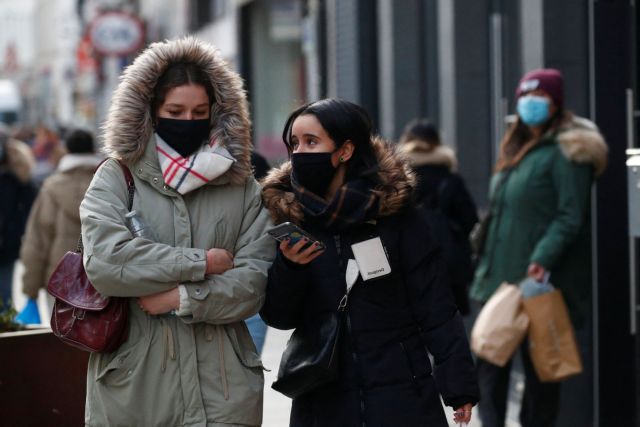
The Omicron sub-variant with the scientific name BA.2, also known as “stealth” or Omicron 2, which is constantly gaining ground in several countries, is not a cause for serious concern, as it is unlikely to “insidiously” create a new catastrophic epidemic. wave and change the course of the pandemic again. It does not appear to cause more serious illness or increase the risk of hospitalization, and the Covid-19 vaccine is just as effective against it as the previous variants, according to the British Health Security Agency.
But because BA.2 seems even more contagious than the original Omicron (one and a half times more than the dominant BA.1 subtype, according to Danish scientists), it can slow the decline in cases in much of the world and therefore prolong the duration of the pandemic. This is a brief overview of the scientific community for BA.2, according to reports in the New York Times and Reuters.
Possible higher case peak
“It is possible that there will be a higher incidence in places where the pandemic has not yet peaked and a slowdown in their declining trend in areas that have already passed the Omicron peak,” said Dr. Thomas Peacock, a virologist at Imperial College.
BA.2 is one of the four “branches” of Omicron, along with the sub-variants BA.1 (dominant so far), BA.3 and BA.1.1.529. The first detection of Omicron was made in South Africa last November and after a few weeks it was realized that there were different versions of Omicron, each of which had some common mutations with the others, but also some mutations unique to each subspecies. The initial Omicron infections were related to BA.1, with BA.2 being rarer and BA.3 even more rare. The latter seems to have come from the infection of the same person with BA.1 and BA.2, with the result that their genes find an opportunity to mix and thus create a new “hybrid” variant of the coronavirus.
Omicron 2 will become dominant
In the first phase, BA.1 surpassed the others with an incidence of 1,000 to 1. However, in recent weeks BA.2 has become more common in countries such as Denmark (where it now accounts for 65% of cases according to the Staten Serum Institute and the 82% according to virologist Trevor Bedford (of the American Fred Hutchinson Center), in Britain (where it is 9% and grows faster than BA.1) and in the USA (where it is at least 8% of cases and the percentage is also increasing rapidly).
“I’m pretty sure BA.2 will become dominant in the United States, but I do not yet know what that could mean for the pandemic,” said Yale University School of Public Health epidemiologist Nathan Grubaugh. He estimated that B.2 would not cause a new big wave, but Omicron’s cases will continue to decrease in the coming weeks, without ruling out a temporary increase, while B.2 is also likely to slow down.
Is there a risk of re-infection with Micron 2?
Omicron – in all its variants – is now the cause of almost all new coronavirus infections worldwide. On January 25, according to the genetic analysis of samples submitted to the international GISAID database, BA.1 was responsible for 98.8% of these infections.
A crucial question, currently unanswered, is whether those who have been infected with the hitherto dominant sub-variant BA.1 of Omicron are at risk of being infected with BA.2 or are protected against it. If not, then according to Dr. Egon Ozer, an infectious disease specialist at Northwestern University School of Medicine in Chicago, “there may be a double wave that will look like a camel’s back, but it’s still too early to tell.” . The good news, however, he stressed, is that “vaccines and boosters will continue to keep people away from the hospital and protect them from death.”
Latest News

IOBE Revises Greek GDP Growth Downward, to 2.1% For 2024
Annual inflation is expected to reach 3%, up from the previous forecast of 2.8%

Last Sections of 136km E65 Highway Inaugurated on Tues.
Athens to Karditsa drive time is expected to drop to two and a half hours (under normal conditions), and some three hours from Athens to Trikala

Reuters: Greece to Repay More Bailout Loans Ahead of Maturity in 2023
The country has relied solely on international markets for its borrowing needs since a third institutional bailout ended in 2018

Ag Min. Avgenakis: Greece-China Cooperation in Research, Education in Agri-Food Sector
Greek minister tours cutting-edge hydroponics and robotics facilities at the Chinese Academy of Agricultural Sciences in Beijing

Mini Holiday Season in Greece for Upcoming Orthodox Easter
Occupancy rates reach up to 90% domestically for accommodations open ahead of peak summer season

Greek PM Mitsotakis Says Fight Against Inflation Ongoing
The Premier made statement during a visit an an open vegetable market

Unpaid Taxes in Greece Reach 1.539bln Euros
As the figures revealed the number of debtors totaled 3,878,712 individuals and legal entities.

ELSTAT: Greek Primary Surplus Reaches 1.9% of GDP in 2023
Greek debt saw a slight dip to 356.7 billion euros by the end of 2023, down from 356.8 billion euros a year prior

Study: Greece in Top 5 Hotel Investments in Europe
As previously reported by OT, more than 60 hotel projects are set to be developed in Greece over the next four years

GEOAXIS Report: Office Rents Surge by 40% in Ten-Year Span
Geoaxis estimates that the different dynamics in the office market will continue into 2024/2025, predicting stability for older offices, increased demand for renovated spaces, and a slowdown in the rise of rents for modern, green offices








![Φυσικό αέριο: Γιατί είναι δύσκολη η απεξάρτηση από τη Ρωσία – Τα εμπόδια [Χάρτης]](https://www.ot.gr/wp-content/uploads/2022/07/gas-1-1-90x90.jpg)


































 Αριθμός Πιστοποίησης Μ.Η.Τ.232433
Αριθμός Πιστοποίησης Μ.Η.Τ.232433